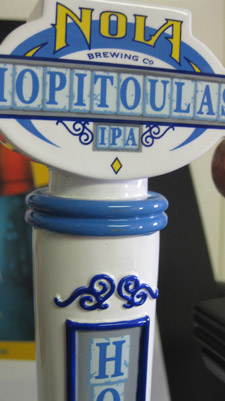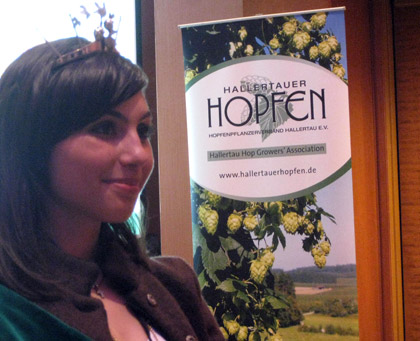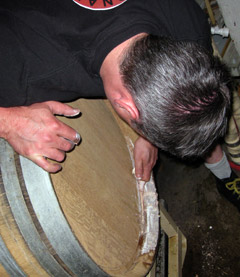 This week New Orleans hosts Tales of the Cocktail.
This week New Orleans hosts Tales of the Cocktail.
We went last week.
Not because we have anything against cocktails, but because that’s when the birthdays fall. In fact, we drank hurricanes at Pat O’Brien’s and cocktails at the Carousel Bar in the Hotel Monteleone. We also had pretty good wine with dinner at Irene’s Cuisine.
But mostly we drank beer. Finding flavorful beer in New Orleans has been relatively easily for a long time. Thank the students at Tulane for supporting places like Cooter Brown’s and The Bulldog. However the city was, and is, the poster child for BMC (Bud Miller Coors) markets. “When we opened a year and a half ago (they) accounted for 95 percent of beer sales,” said NOLA Brewing founder Kirk Coco. “I don’t mean all light lagers. Just beers from Bud, Miller and Coors.”
NOLA (New Orleans Lager and Ale) hasn’t even begun to approach the status of Abita, but the fact that Crescent Pie & Sausage, located in Mid-City and one of the city’s hip new dining spots, offers three NOLA beers on tap signals that change is at hand.
We built our itinerary around eating, and there was much to be said to finding Abita or NOLA beers available at almost every turn. Beer and food should go together in New Orleans, Coco said. “We have the right attitude. We’re not afraid of calories.”
He pointed out New Orleans’ shortage of diet po-boy shops and promised, “You’ll never see a NOLA Light, not as long as I’m alive.”
These are not necessarily “Big Ass Beers” (as seen on signs throughout the French Quarter). NOLA Blonde, 4.9% abv, outsells all the others three-to-one. Coco’s favorite is NOLA Brown, at 3.9% abv tame but rich. A beer some would surely describe as quaffable.
Hopitulous IPA — the brewery is located on historically important Tchoupitoulas Street; Tipitina’s is at the corner of Tchoupitoulas and Napoleon and if I need to explain Tip’s please just Google Professor Longhair — was supposed to be a seasonal, but proved too popular not to keep brewing. It’s more about hop flavor than bitterness (60 IBU, calculated). Brewmaster Peter Caddoo, a veteran of Dixie Brewing, adds Nugget hops while running wort into the kettle. He uses Warrior for bittering, Columbus and Cascade for flavor, Simcoe late in the kettle, then more Simcoe in the whirlpool. He dry hops it with Simcoe and Amarillo.
It’s a fine food beer. I might just mail in “eating the Mixed Grill (a plate of house-made sausages) at Crescent Pie and Sausage served Hopitulous” as my entry for The Session #42. Each made the other better.
Two other bits I should probably save for future stories, but can’t resist passing on:
– When did Peter Caddoo begin homebrewing? “The day John Lennon died.” That was Dec. 8, 1980 and he was a student the the Culinary Institute of American in Hyde Park, N.Y. He and the other students made “Lennon Lager” and drank it on New Year’s Eve.
– Although Cooter Brown’s, The Bulldog and d.b.a. (in the Marigny/Bywater neighborhood) remain fine places to drink and have been joined by Bulldog Mid-City, The Avenue Pub on St. Charles has vaulted to the top of the class.
This joint has been around forever (maybe the nineteenth century). Story is that more recently celebrity chef Emeril Lagasse played pool in the back room after he go off work. When we first visited several years ago the beer was OK, and sitting beside one of the windows looking onto St. Charles was pretty terrific. However, a few years ago (not long before Katrina and on a Jazz & Heritage Festival weekend) somebody suggested it hard turned into a dive.
Not today. After her father died Polly Watts turned it into as good a beer place as any of us should need. For instance, Garrett Oliver of Brooklyn Brewery is in town this week for Tales of the Cocktail so the pub is featuring special Brooklyn beers all week. Oliver will make an appearance Friday.
Perhaps he heard that Craig and Kim Giesecke of J’Anita’s took over the kitchen after their place on Magazine closed. They’re not afraid of calories.

 Part Two. Beers aged in barrels, sour and otherwise. Attendees filled the chairs, lined up along all the walls and took seats in the aisles for Vinnie Cilurzo’s talk called “Toothpicks, Garlic and Chalk: Three Key Ingredients to Any Brewery’s Barrel-Aged Sour Beer Program.” (In the photo on the right Cilurzo is using those tools to plug a leaking barrel at the Russian River brewpub.)
Part Two. Beers aged in barrels, sour and otherwise. Attendees filled the chairs, lined up along all the walls and took seats in the aisles for Vinnie Cilurzo’s talk called “Toothpicks, Garlic and Chalk: Three Key Ingredients to Any Brewery’s Barrel-Aged Sour Beer Program.” (In the photo on the right Cilurzo is using those tools to plug a leaking barrel at the Russian River brewpub.)